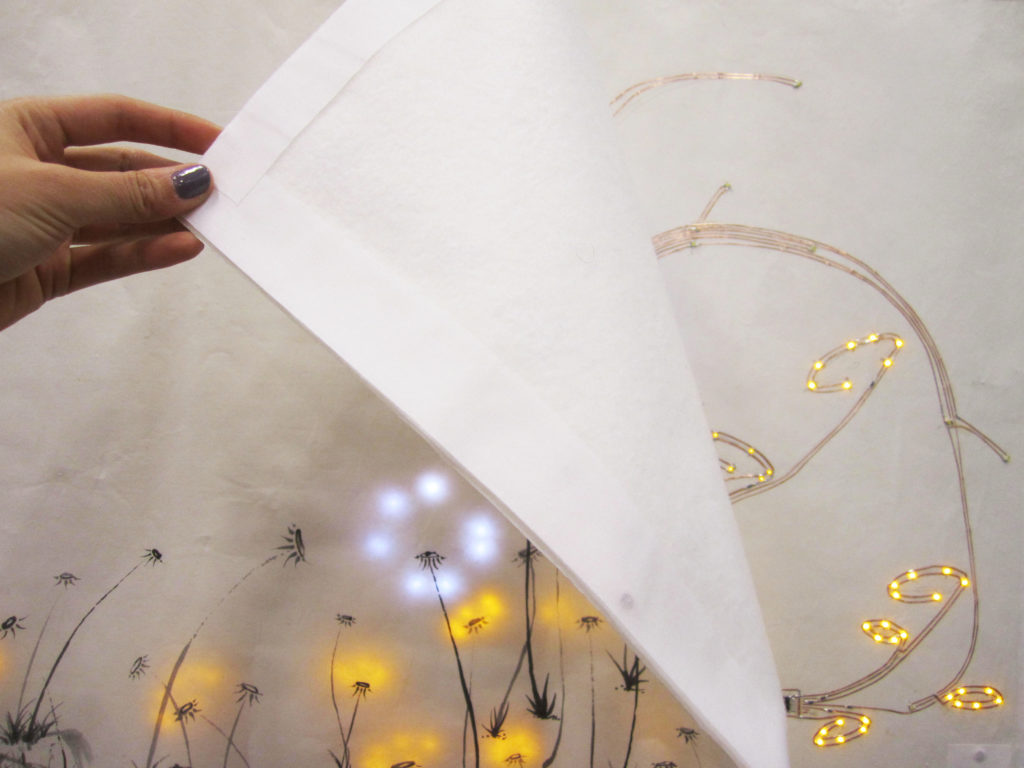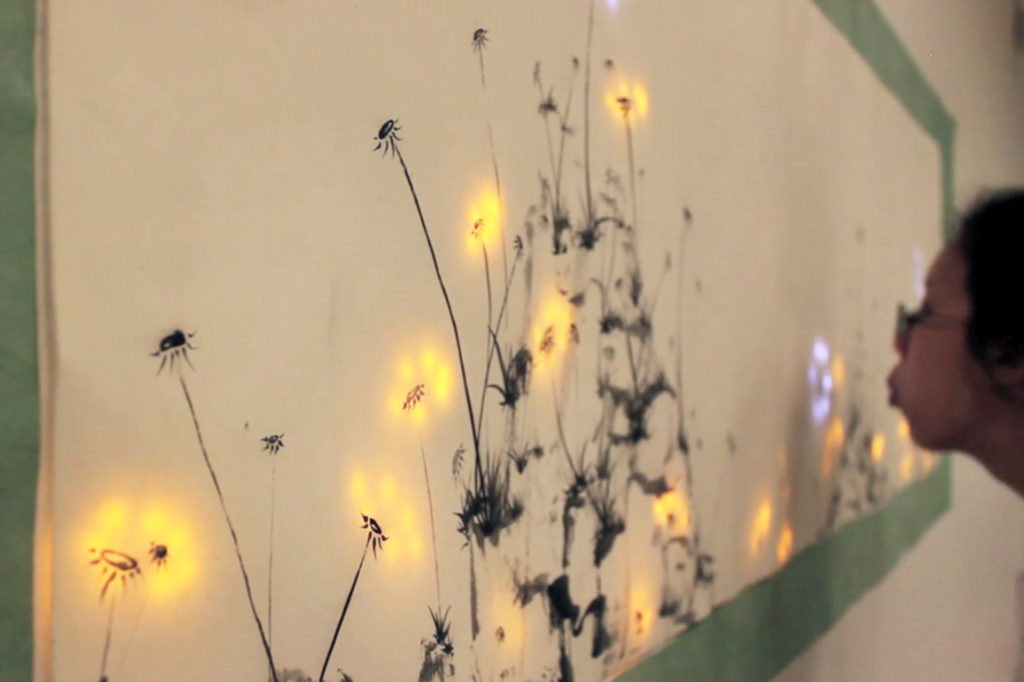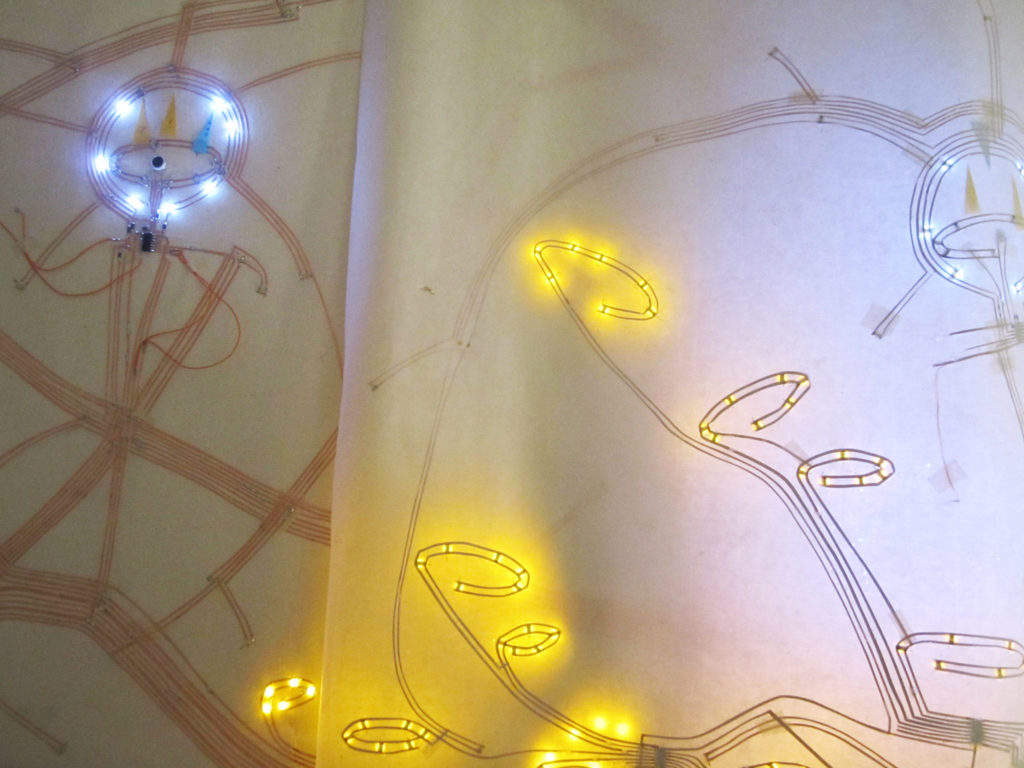Pu Gong Ying Tu (Dandelion Painting)
Pu Gong Ying Tu (Dandelion Painting)
An interactive landscape painting that comes to life when you blow on its dandelion puffs, generating new flowers. Created using Chinese ink painting and handmade copper tape circuitry.
This work has grown to be an exemplar of what paper circuitry can do as a medium and has since seeded numerous remixes by other creators, taking on yet a new dimension of the living painting.
Collaborators:
Brian Chan
John Clifford
Inspired by:
Jessie Thompson and Zach Berta’s
What Makes a Weed not be a Flower?
2012
Read More:
The Painting
The Concept
The Making
Collections:
MoMA
Research Publications:
Hybrid Craft: Showcase of Physical and Digital Integration of Design and Craft Skills.
Amit Zoran, Seppo O. Valjakka, Brian Chan, Atar Brosh, Rab Gordon, Yael Friedman, Justin Marshall, Katie Bunnell, Tavs Jorgensen, Factum Arte, Shane Hope, Peter Schmitt, Leah Buechley, Jie Qi, and Jennifer Jacobs Leonardo 2015 48:4, 384-399. 2015
External Links:
Photo Album: Completed Painting
Photo Album: Production Process
The Painting
Pu Gong Ying Tu, which translates from Chinese to Dandelion Painting, is an exploration in blending elements of traditional ink painting– color, texture, composition–with those of contemporary technologies– sensing, actuation, computation, dynamism–to explore new modes of storytelling and interacting with the digital world.




This painting is made in two parts: on top is a traditional Chinese ink brush painting and below is a circuitry made with copper tape, LEDs, sensors and programmed microcontrollers. Between them is a white fabric to diffuse the LEDs, adding texture to the light.

At each dandelion, a microphone listens for the sound of wind. Yellow and white LED lights, which are coded to brighten or dim, act as dynamic programmable paint strokes which make up the petals and seeds.

Each flower is linked to several neighboring flowers so that when its seeds disperse, the flower also sends an electrical signal–a digital seed–for the new flower to regenerate.

Just as the lines of paint make up the form of the landscape, so do the lines of copper tape traces carefully laid to create their own scene. While these copper lines act as electrical connections for signals in the circuit, their shape also follows the contours of the flowers, the flow of the seeds and the composition of the landscape–creating another layer in representation, computational as well as visual.




The Concept
In The Enchantment of Modern Life, Jane Bennett describes wonder as
“Being struck by the extraordinary that lives amid the familiar and everyday. [It feels like] a ‘moment of pure presence’ where thoughts and limbs are brought to rest, even as the senses continue to operate, indeed, in high gear. You notice new colors, discern details previously ignored and hear extraordinary sounds, as familiar landscapes of sense sharpen and intensify [1].“
The experience of wonder seeds the ordinary world around us with a sense of magical possibility that was not there before, which enriches our surroundings and, through it, ourselves.
This sense of surprise awakening is also why when technology is seamlessly integrated into the commonplace, it can evoke a sense of wonder. For example when familiar inanimate materials come to life with electronic interactivity—such as a painting of a dandelion that actually responds to our breath. It is the feeling of wonder that fuels our curiosity, enticing us to explore new worlds, engage in learning and invent new experiences.
However, wonder is more than just surprise. If the new and unexpected are perceived to be threatening, we experience fear. Instead of heightening our senses, fear shuts down our perception as we try to push back the perceived threat and run away back to safety.
Wonder is a state of interactive fascination, not fearful awe. Once the novel is confirmed to be non-threatening, our curiosity gets unlocked leading us to welcome and try to understand these new encounters. If we manage to explore and successfully explain the new phenomenon, we feel the pleasure of re-normalizing the extraordinary and in the process, we grow our understanding of the ordinary world into something more [2].

Likewise, technology is often a foreign entity that is boxed away from the user, due to their fragility and potential hazard. However, by presenting technology through familiar means or unexpected media, like craft materials, we can nurture a sense of wonder and dispel the fear often associated with using, making or even understanding computational devices.
Through encouraging individuals to not just interact with but also create technology, we empower them to use their understanding to create new experiences for themselves and others, new experiences that were not possible before. When we engage individuals in sharing their voices through building technology, a medium that was once open only to “trained experts,” what might they say? What new stories will be told? And in the process, what might we learn about ourselves and our relationships to technology?
References
[1] Jane Bennett. The Enchantment of Modern Life. Princeton University Press, 2001. Pg 68.
[2] Phillip Fisher. Wonder, the Rainbow and the Aesthetics of Rare Experiences. Harvard University Press, 1998. Pg 102.
The Making
I created this painting in my early twenties, a time when I was just beginning to explore my own hybrid heritage as a Chinese-born immigrant to the US. I had gotten interested in ink painting, which dovetailed nicely with my interest in interactive technologies: in Chinese folklore, ink painting is a medium known for coming to life.
Perhaps for this reason, there are signature large swaths of negative space typical in Chinese painting compositions–they give room for the image to breath, for elements inside to take on life. These spaces also become the perfect “screen” for layering dynamic digital animations.
During this period, I was teaching a workshop series to students at MIT on paper electronics as an expressive medium. During a session on sensors, a student named Jessie Thompson with a background in botany came up with the idea of making a plant that is responsive to sound and wind: a dandelion. She and her partner Zach Berta created this poster, titled What Makes a Weed not be a Flower:
I fell in love with Jessie and Zach’s magical dandelion (as have many others since!) and was inspired to create a full landscape ink painting based on this concept.
Making the painting itself was a process in experimenting with the circuit, the paint and the light. I first created an abstract representation of the circuit to test the connections, power and code. Then I painted the dandelions and used the painting as a guide for laying down the circuitry, one dandelion at a time, building up the circuitry in layers. Finally, I experimented with various diffusion materials until I found the right mix of texture, opacity and depth.



This piece represents for me the value of democratizing technology as an expressive medium. It’s by inviting new perspectives, like Jessie and Zach’s, that we inspire entirely new interactions, technologies and artistic statements.
I’m also grateful to my skilled collaborators, artists Brian Chan and John Clifford, who guided me on my journey in learning Chinese ink painting, calligraphy and mounting techniques. Without their expertise, this piece would also not be possible.





